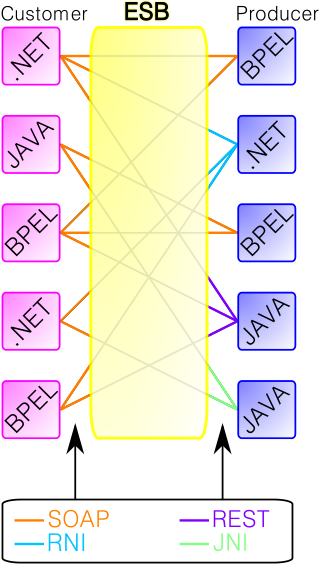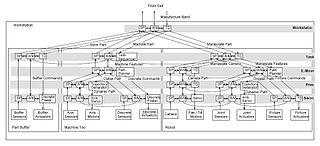A web service (WS) is either:

GNUnet is a software framework for decentralized, peer-to-peer networking and an official GNU package. The framework offers link encryption, peer discovery, resource allocation, communication over many transports and various basic peer-to-peer algorithms for routing, multicast and network size estimation.
In software engineering, service-oriented architecture (SOA) is an architectural style that focuses on discrete services instead of a monolithic design. By consequence, it is also applied in the field of software design where services are provided to the other components by application components, through a communication protocol over a network. A service is a discrete unit of functionality that can be accessed remotely and acted upon and updated independently, such as retrieving a credit card statement online. SOA is also intended to be independent of vendors, products and technologies.

An enterprise service bus (ESB) implements a communication system between mutually interacting software applications in a service-oriented architecture (SOA). It represents a software architecture for distributed computing, and is a special variant of the more general client-server model, wherein any application may behave as server or client. ESB promotes agility and flexibility with regard to high-level protocol communication between applications. Its primary use is in enterprise application integration (EAI) of heterogeneous and complex service landscapes.

A multi-agent system is a computerized system composed of multiple interacting intelligent agents. Multi-agent systems can solve problems that are difficult or impossible for an individual agent or a monolithic system to solve. Intelligence may include methodic, functional, procedural approaches, algorithmic search or reinforcement learning.
A blackboard system is an artificial intelligence approach based on the blackboard architectural model, where a common knowledge base, the "blackboard", is iteratively updated by a diverse group of specialist knowledge sources, starting with a problem specification and ending with a solution. Each knowledge source updates the blackboard with a partial solution when its internal constraints match the blackboard state. In this way, the specialists work together to solve the problem. The blackboard model was originally designed as a way to handle complex, ill-defined problems, where the solution is the sum of its parts.

Mahadev "Satya" Satyanarayanan is an Indian experimental computer scientist, an ACM and IEEE fellow, and the Carnegie Group Professor of Computer Science at Carnegie Mellon University (CMU).

A network on a chip or network-on-chip is a network-based communications subsystem on an integrated circuit ("microchip"), most typically between modules in a system on a chip (SoC). The modules on the IC are typically semiconductor IP cores schematizing various functions of the computer system, and are designed to be modular in the sense of network science. The network on chip is a router-based packet switching network between SoC modules.
Decentralized computing is the allocation of resources, both hardware and software, to each individual workstation, or office location. In contrast, centralized computing exists when the majority of functions are carried out, or obtained from a remote centralized location. Decentralized computing is a trend in modern-day business environments. This is the opposite of centralized computing, which was prevalent during the early days of computers. A decentralized computer system has many benefits over a conventional centralized network. Desktop computers have advanced so rapidly, that their potential performance far exceeds the requirements of most business applications. This results in most desktop computers remaining idle. A decentralized system can use the potential of these systems to maximize efficiency. However, it is debatable whether these networks increase overall effectiveness.
System integration is defined in engineering as the process of bringing together the component sub-systems into one system and ensuring that the subsystems function together as a system, and in information technology as the process of linking together different computing systems and software applications physically or functionally, to act as a coordinated whole.
James D. McCaffrey is an American research software engineer at Microsoft Research known for his contributions to machine learning, combinatorics, and software test automation.
Search-based software engineering (SBSE) applies metaheuristic search techniques such as genetic algorithms, simulated annealing and tabu search to software engineering problems. Many activities in software engineering can be stated as optimization problems. Optimization techniques of operations research such as linear programming or dynamic programming are often impractical for large scale software engineering problems because of their computational complexity or their assumptions on the problem structure. Researchers and practitioners use metaheuristic search techniques, which impose little assumptions on the problem structure, to find near-optimal or "good-enough" solutions.

Real-time Control System (RCS) is a reference model architecture, suitable for many software-intensive, real-time computing control problem domains. It defines the types of functions needed in a real-time intelligent control system, and how these functions relate to each other.
TriDAR, or Triangulation and LIDAR Automated Rendezvous and Docking, is a relative navigation vision system developed by Neptec Design Group and funded by the Canadian Space Agency and NASA. It provides guidance information that can be used to guide an unmanned vehicle during rendezvous and docking operations in space. TriDAR does not rely on any reference markers positioned on the target spacecraft. Instead, TriDAR relies on a laser based 3D sensor and a thermal imager. TriDAR's proprietary software uses the geometric information contained in successive 3D images to match against the known shape of the target object and calculate its position and orientation.
In software engineering, a microservice architecture is a variant of the service-oriented architecture structural style. It is an architectural pattern that arranges an application as a collection of loosely coupled, fine-grained services, communicating through lightweight protocols. One of its goals is that teams can develop and deploy their services independently of others. This is achieved by the reduction of several dependencies in the code base, allowing developers to evolve their services with limited restrictions from users, and for additional complexity to be hidden from users. As a consequence, organizations are able to develop software with fast growth and size, as well as use off-the-shelf services more easily. Communication requirements are reduced. These benefits come at a cost to maintaining the decoupling. Interfaces need to be designed carefully and treated as a public API. One technique that is used is having multiple interfaces on the same service, or multiple versions of the same service, so as to not disrupt existing users of the code.
Robot as a service or robotics as a service (RaaS) is a cloud computing unit that facilitates the seamless integration of robot and embedded devices into Web and cloud computing environment. In terms of service-oriented architecture (SOA), a RaaS unit includes services for performing functionality, a service directory for discovery and publishing, and service clients for user's direct access. The current RaaS implementation facilitates SOAP and RESTful communications between RaaS units and the other cloud computing units. Hardware support and standards are available to support RaaS implementation. Devices Profile for Web Services (DPWS) defines implementation constraints to enable secure Web Service messaging, discovery, description, and eventing on resource-constrained devices between Web services and devices.
Elena Ferrari is a Professor of Computer Science and Director of the STRICT Social Lab at the Università degli Studi dell’Insubria, Varese, Italy. Ferrari was named Fellow of the Institute of Electrical and Electronics Engineers (IEEE) in 2013 for contributions to security and privacy for data and applications. She has been named one of the “50 Most Influential Italian Women in Tech” in 2018. She was elected as an ACM Fellow in 2019 "for contributions to security and privacy of data and social network systems".
Executable choreography represents a decentralized form of service composition, involving the cooperation of several individual entities. It is an improved form of service choreography. Executable choreographies can be intuitively seen as arbitrary complex workflows that get executed in systems belonging to multiple organisations or authorities.






